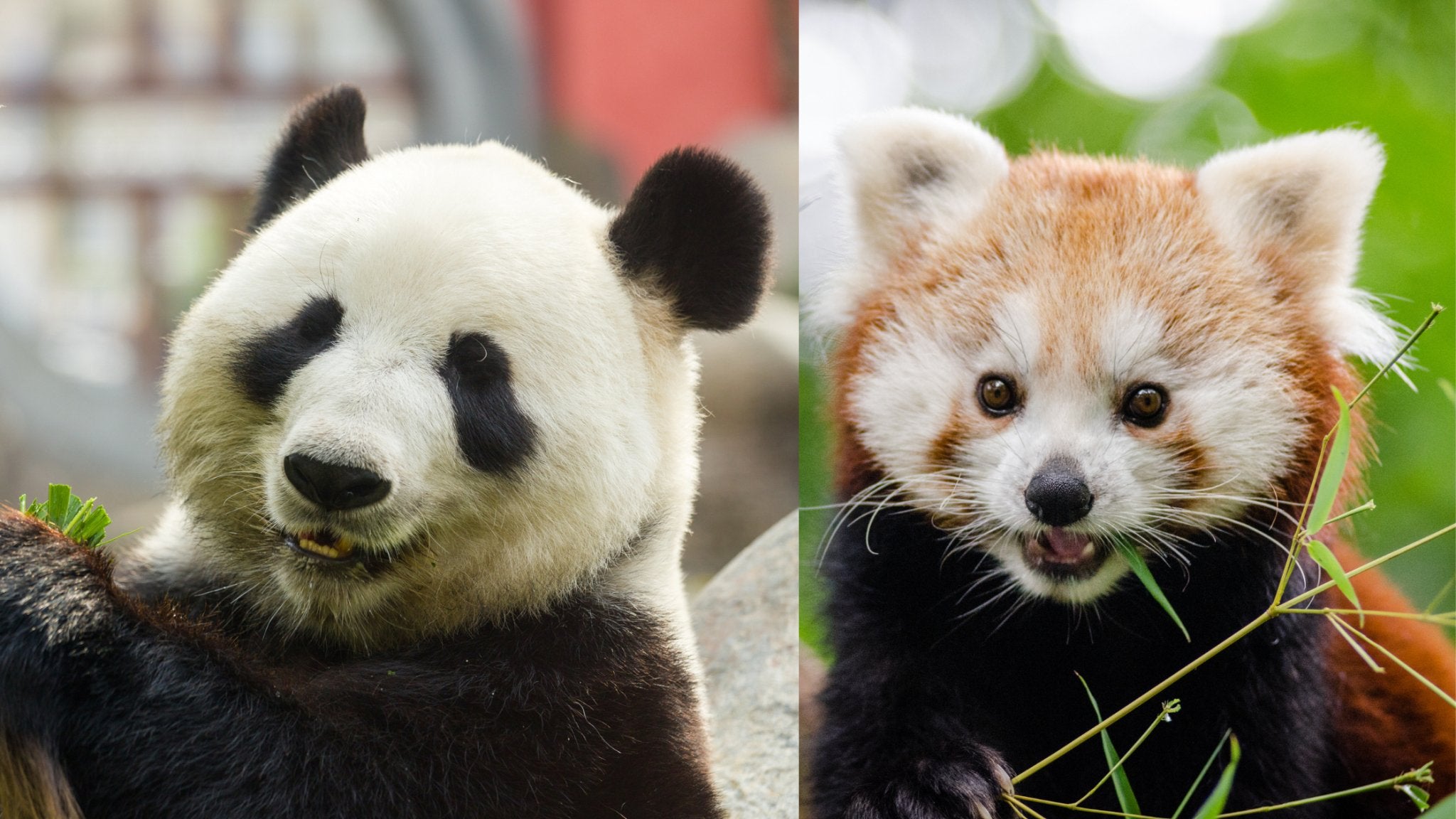Two different species of animals on our beautiful planet are known as pandas.
One is the Giant Panda - a bear.
And the other is the Red Panda - not a bear.
Let’s find out more about these awesome animals!
The Giant Panda Bear
The Giant Panda is found exclusively in China. Some have been imported to zoos, but in the wild, giant pandas live in the bamboo forests of China.

In fact, the adorably cute, chubby-cheeked bears weren’t known outside of China before the 20th century, even though scientists have found evidence that pandas have been around for at least 2-3 million years!
Where were they hiding all this time?
A giant panda can weigh as much as 330 pounds and, on its hind legs, stand 6 feet tall. How did it go unnoticed?
Elusive and solitary, pandas spend much of their time hanging out by themselves, munching on bamboo.
Pandas Aren't Like Other Bears
While the Giant Panda is a member of the bear family, a few habits separate the species from other bears.
Diet
The panda bear’s diet is pretty boring. Other bears eat almost anything. But most of the time, 90% in fact, the panda eats only bamboo.
Although there are 300 varieties of bamboo growing in China, the areas where pandas live have about 25 types of bamboo. They seem particularly fond of umbrella, arrow, and golden varieties.

And those chubby cheeks? Those are nothing but muscle! The combination of powerful muscles and molar teeth are how pandas can crush tough stalks of bamboo. And they eat a lot of bamboo.
An adult panda will eat up to 75 pounds…yes, 75 pounds, or about 34 kilograms, of bamboo every day!
Pandas eat so much of bamboo because the stalky plant isn’t very nutritious. Because they eat so much of it, most of their time awake is spent munching on bamboo.

All that chewing is apparently exhausting work, because pandas do love their nap time. After eating, a panda will sleep from 2-4 hours!
Hibernation, or Not
Pandas also don’t hibernate like other bears. Instead, when the weather in the higher elevations of China starts to get chilly, they move to the lower elevations.
The diet of bamboo is thought to be the main reason for this. They can’t build up enough fat reserves to be able to sleep for a few months like other bears!
Pause for Bear Paws
Another assist in munching on bamboo is their paws. They have a special adaptation by way of a modified wrist bone, which they use like an opposable thumb. It helps in grabbing and breaking bamboo shoots.
Fun stuff about giant pandas:
China considers the panda a national treasure, and it’s seen as a symbol of peace. In ancient times, warring tribes would wave a picture of a panda to signal a truce.

The black and white fur pattern of a panda is the same as its skin color. Where the fur is white, the skin is pale. The black patches of fur grow out of black patches of skin.
Giant pandas have two sets of teeth, just like humans. The first set comes in when the panda is still a baby. By age two, that set falls out and is replaced by a permanent set of teeth. Bet they don’t have a panda bear tooth fairy, though.
The giant panda lives in the provinces of Sichuan, Shanxi, and Gansu, which is about in the middle of the country. These areas are cool and temperate, and bamboo grows in abundance.
What About This Red Panda Not-A-Bear?
Even though the Giant Panda and the Red Panda are both called pandas, they aren’t related. The word “panda” is thought to have come from the Nepalese words nigalya ponya, which means “bamboo eater.”

The red panda is also found in China. They also live in Nepal, India, Bhutan, and Myanmar. Depending on where you are, they have different names. Like in Nepal, they’re called bhalu biralo. Sherpas in the Himalayas call them ye niglva.
They could have been named “Wha.”
That’s what their call sounds like. Which is how the little critter was found!

In 1821, an English naturalist discovered the small, furry mammal and presented it to the scientific community.
Unfortunately for him, a French zoologist published a paper on the red panda, complete with descriptions and drawings, before the naturalist… And the zoologist got the naming rights.
Known as the “first panda,” the red panda was discovered almost 50 years before the giant panda.
Red Panda Not-A-Bear Is More Like A Raccoon or Skunk
The red panda is actually more in line with a racoon or a skunk, rather than a bear. It’s the only member of the Ailuridae family. The scientific name for a red panda is Ailurus fulgens, which means “red, shining cat.”

It’s tiny, too. An adult red panda is only slightly larger than a domestic house cat!
The only real similarity between giant pandas and red pandas is their eating… and sleeping… habits. Both eat lots of bamboo. They both sleep a lot.
Fun stuff about red pandas:
Looking at its shiny red and black coat, you wouldn’t think that would make very good camouflage. One of its hiding places is a fir tree which is usually covered in a reddish-brown moss. The color of its fur blends in quite nicely.
They’re also called “fire fox” because of their size and color.
Their tails, aside from being luxurious, are an important feature. They use their long tails for balance as they move among tree branches, kind of like a cat. A red panda's tail is as long as its body! They also curl their tails around them when they're sleeping.

Its tail can help to keep the red panda warm, and although it doesn’t hibernate, when the temperature gets really cold, it can go dormant. That means its body temperature and the energy it uses drop significantly. It will wake up every few hours to eat though.
Red pandas also have a modified wrist bone which they use to help them climb trees and hold their food while they eat.
Giant or Red, The Pandas of China Are Amazing
We love the bamboo-munching sleepy pandas living in southeast Asia. Even though they aren’t related in any way, there are a couple similarities shared by these unique animals. One of which is cuteness!
While we don't munch on bamboo, we can certainly enjoy the flavors of China! Check out our China box and you can eat2explore!







